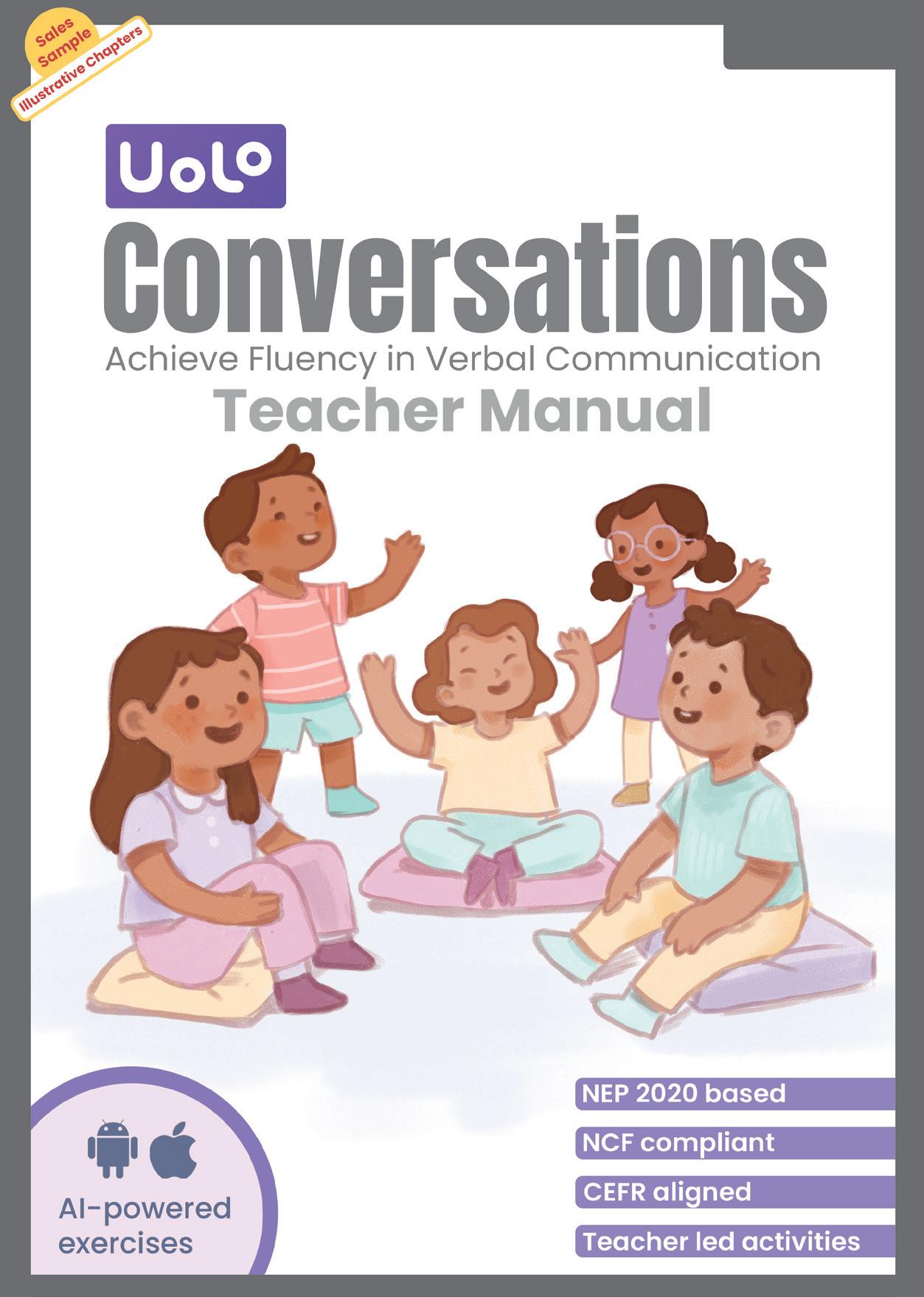
Grade 3

Achieve Fluency in Verbal Communication Grade 3 Teacher Manual
Conversations
Thanks to globalization and the emergence of technologies, international boundaries have become blurred. English, to a high degree, is a commonly understood medium of communication. It is one of the key tools that students need to perform well today and in the future. According to a global study, while recruiting, 98.5% of employers implicitly or explicitly assess a candidate’s English communication skills! There is therefore a growing demand for English communication skills, because it empowers people and enables them to lead a better life.
Functional communication skills, involving aspects of LSRW (listening, speaking, reading and writing), are central to knowledge acquisition, children’s intellectual, social and emotional growth, and life-long learning.
Specifically, strong listening and speaking skills are not only vital in the overall language learning process, but also lead to better reading and writing skills. Yet, these foundational skills tend to be neglected in schools due to the high pupil-teacher ratio, lack of oral language-focused assessment, and most importantly, a lack of systematic and allocated practice time for these skills within the classroom.
Aligned with NEP 2020, NCERT learning outcomes and standardized to CEFR (Common European Framework for Reference) levels, Uolo Speak is a hybrid learning program that focuses on building, applying, practising, and assessing these core language skills.

First, through this book as one of the components of the program, the English classroom becomes an avenue to hone functional speaking skills in real time. The teacher-led activities give learners the opportunity to undertake high-quality, level-appropriate, and experiential activities that help to build confidence and expression in English.
Second, the mobile interface of the product ensures consistent practice of functional LSRW skills. These exercises go beyond traditional question types and employ cutting-edge technology to enable learning and generate instant feedback. For instance, learners practise speaking with Al (artificial intelligence), as if conversing with a real person!
Third, Uolo Speak assessment can be conducted by the school in sync with their academic calendars. The assessment is evaluated by Uolo’s English specialists to give performance report and feedback.
Foreword
ii
Finally, the reporting methodology used in the above three program components, generates a skill growth chart against CEFR levels for each learner, class and the school. Educators can then clearly identify learners who are reaching, meeting, and exceeding the level requirements, and support them accordingly.
Uolo Speak is a powerful, exciting, and unique experience for learners and teachers. It represents a real life and results-oriented approach to develop essential 21st century functional English skills.
Wishing all teachers, parents, and learners lots of fun and joyful experiences as you embark upon this exciting journey with Uolo Speak.
Dr Laraine O'Connell

D. Litt., English, North West University, South Africa
I am a veteran English teacher and lecturer, with a great love for English and for teaching. I have taught English and trained teachers over many years. I live in South Africa and it is a wonderful experience working with a company promoting the learning of English in India.
Foreword
iii
Walkthrough
Each chapter is divided into three sections - Part A, E-Speak, Part B.

Part A should be completed in period 1, which includes reading aloud of a text and one listening-speaking activity to practise the competency targeted in the chapter.

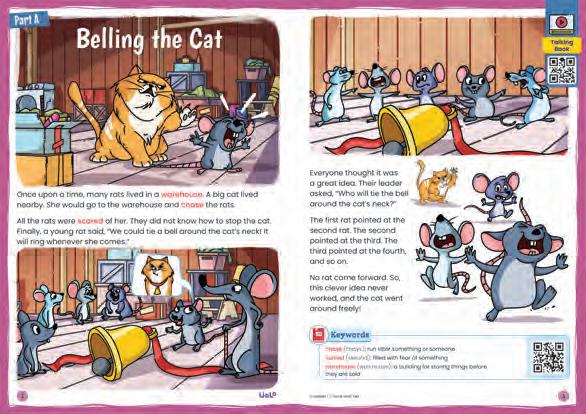



E-Speak comprises two digital activities aligned with target competency, which can be accessed through the given QR codes. These activities can be done at home or in school.

Part B focuses on learners’ presentations, which is prescribed to happen in period 2 after adequate practice of the chapter competency. It begins with a small warm up activity.
Tells the chapter number and chapter title, along with an image to convey the main idea of the chapter
A text to be read aloud and discussed in period 1
Scan the QR code to watch the animation of the text on mobile app
Scan the QR code to listen to the pronunciation of difficult words from text
iv
One listening speaking activity for practice in period 1
Prompts for learners to help them think before speaking
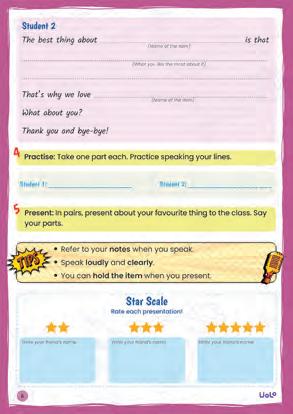
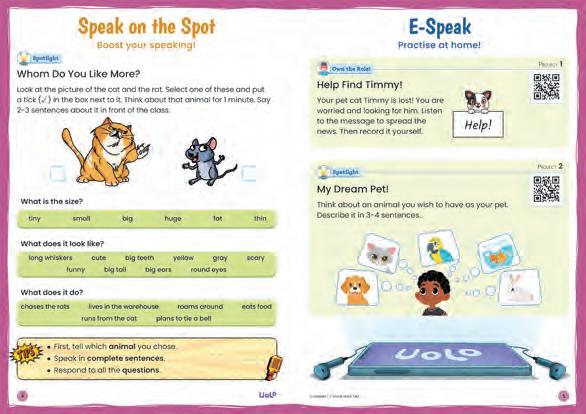






Quick tips for learners to help them make their interestingpresentations
To get learners warmed up at the beginning of period 2
Digital section of the book, which features QR codes for two mobile app activities
Types of Activities
Learners work individually
Learners work in pairs
Learners work in groups of three/four/five
Teacher does the activity along with the whole class
Solo/pair/group presentations by learners, tied to the theme and competency of the chapter, in period 2
Graphic organisers for learners to plan for the presentation and write notes before speaking
Space for learners to reflect on peers’ presentations and write their thoughts
v Walkthrough

Contents Chapter Outcomes vii Random Student Selection Activities ix Student Tracking Sheet x 1 Think and Tell 2 Belling the Cat 2 It’s Rhyme Time! 6 Win Some, Lose a Few 3 Let’s Imagine 10 Baani and Her Balloon vi
Chapter Outcomes
Chapter No. Chapter Name Big Skill
1 Think and Tell Describing something
2 It's Rhyme Time Creating short rhyming lines and present them to an audience
3 Let's Imagine Talking about imaginations and thoughts
Listening Speaking Competencies
Listen to descriptions in order to identify key details
Describe a person/ place/ animal/ thing with fluency, confidence and expressions
Create short rhyming lines Sing rhyming lines with fluency, rhythm and expressions
Appreciate and enjoy imaginary audio texts Verbally share their imaginations and thoughts with appropriate expression
vii
Random Student Selection Activities
In order to ensure the participation of the maximum number of learners during the classroom presentations and to keep the surprise element going, you can try the following quick games for inviting learners to participate:
• Pick the name chits from a bowl.
• Call out the roll number in a random fashion.
• Say some unique identification markers, e.g. the one who is carrying a blue water bottle, the one whose name starts with A, the one whose name ends with P, the one who has a red bag.
• Throw a ball and give an opportunity to the one who catches it.
• Sing a song/recite a poem while students swiftly pass an object on to each other. The one who is holding it when the song/poem ends, has to present.
• After their presentation, each student invites the next presenter.
• Open a book randomly at a page. Call out that (roll) number for presentation.
ix
Chapter 1 Chapter 2 Chapter 3
Student Number/Name

Plan and Speak
Speak on the Spot
Plan and Speak
Speak on the Spot x
Plan and Speak
Student
Tracking Sheet
Speak on the Spot
Chapter 4 Chapter 5 Chapter 6 Chapter 7 Chapter 8 Chapter 9
Plan and Speak
Speak on the Spot
Plan and Speak
Speak on the Spot
Plan and Speak
Speak on the Spot
Plan and Speak
Speak on the Spot
Plan and Speak
Speak on the Spot 1 Student Tracking Sheet
Plan and Speak
Speak on the Spot
About the Chapter: Through this chapter, learners will develop the skill of describing something.

Listening Speaking Competencies: Learners will be able to
• listen to descriptions in order to identify key details.
• describe a person/place/animal/thing with fluency, confidence and expression.

Part A - Period 1
Belling the Cat
• Read aloud the story OR play the Talking Book in the class.
10 min
• Ask questions as follows. Invite responses from as many learners as possible.
Before story: Why are rats scared of cats?
During Story: After “Who will tie the bell around the cat’s neck?": Do you think anyone will come forward to tie a bell around the cat’s neck? Why?
After story: What do you think the cat feels like now?
Speak on the Spot!
Whom Do You Like More?
• Instruct:
20 min
A. Think about who do you like more - the cat or the rat! Put a tick (√) against it.
B. Think about that animal. Refer to the 3 questionsWhat is the size? How does it look? What does it do?
C. Use the prompts to get ideas.
D. Give an example: I like the cat. It is very fat and scary. It has a big tail. It runs after the rats.
• Allot 1-2 minutes to think.
• Say: Now I will call some of you to tell us about the animal you like. Take care of the following things:
A. First, say which animal you like.
B. Speak in complete sentences as you answer the 3 questions.
C. Speak in a flow.

• Invite AS MANY learners to present. Select randomly through games. (page vii)
• Sample:
Hello! I like the rat. He is very small. His eyes are big and round. His ears are also very big. The rat looks very funny. He lives in the warehouse Thank you.
Chapter 1 Think and Tell 2
Very good! You described the rat very well. Just take care to speak a bit more loudly.
Homework 1: E-Speak
Instruct the learners to complete both the projects in the E-Speak section.

Project 1: Help Find Timmy!
This project will be automatically evaluated. Scan the QR code to see the submissions of your learners.
Project 2: My Dream Pet!
This project will be evaluated by you. Scan the QR code to see the submissions of your learners.
Homework 2: Preparation for Part B
Explain steps 1-4 in the Plan and Speak section for prep-work. Facilitate as follows.
1. Divide the class into pairs.
2. Instruct the pairs to pick any one item from their surroundings that they like the most. Guide them to use the prompts for ideas, if needed.
3. Instruct learners to discuss in pairs and write notes to describe that item. Guide them to look at the hints given below each line.
4. Suggest them to take one part each in the pair and practice speaking their lines.
3 Chapter 1 • Think and Tell
5 min
• Instruct learners to draw the path from mouse to burrow.
• You could also set a time limit to give it the flavour of a fun competition!
• Roam around and see the path learners drew. Appreciate them.

Plan and Speak
Our Favourite Thing
• Warm Up 5 min
A. Recapitulate the activity for the learners.
B. Instruct: Revise the notes with your partner. Practice saying your parts.



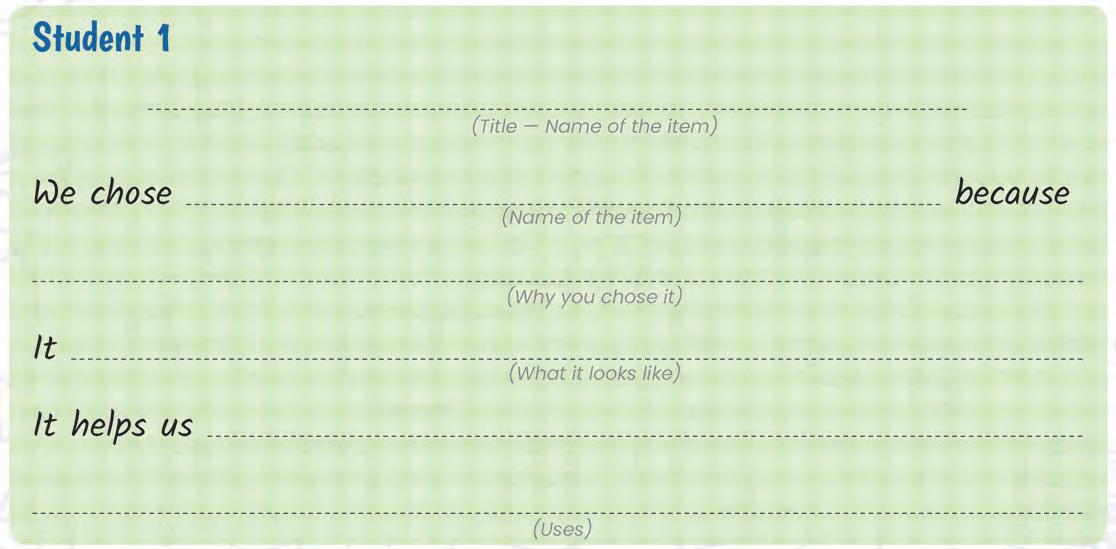
• Presentation and Feedback 30 min
• Invite ALL pairs for the presentation. Select randomly through games. (page vii)
Water Bottle a water bottle it is very useful. comes in many colours. to drink water or juice.
Part B - Period 2
• Sample: 4
a water bottle we can take it anywhere. It never lets us be thirsty! a water bottle.
• Appreciate all presentations. Give concrete feedback on content, fluency, presentation style and team work.

“Thank you. I really appreciate how nicely you described the uses of a water bottle. You spoke clearly. But next time, make sure that both members in the pair speak. Also, don’t be scared. We are all your friends here.”
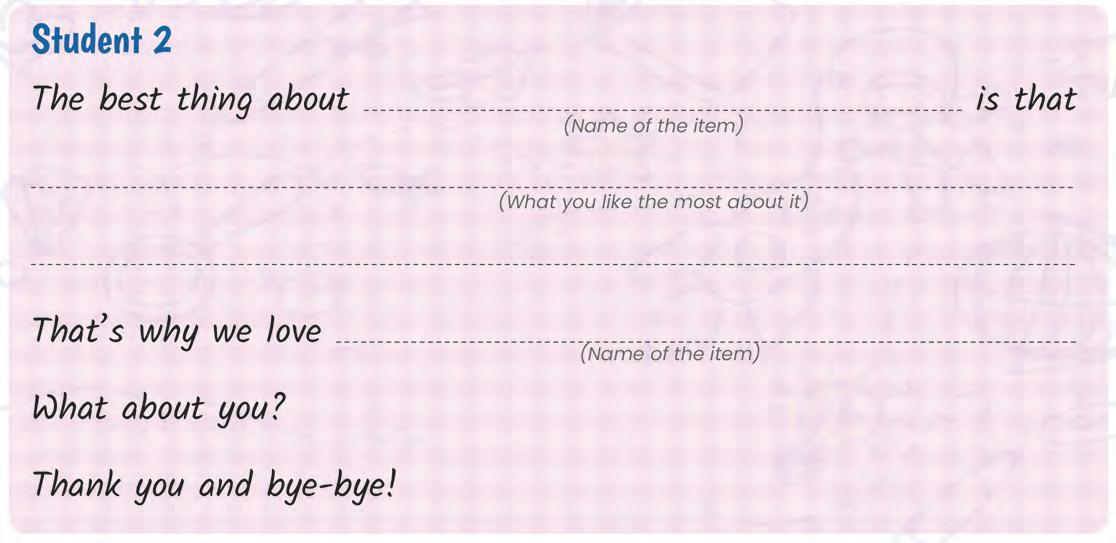
5 Chapter 1 • Think and Tell


6

7 Chapter 2 • It’s Rhyme Time!


8

9 Chapter 2 • It’s Rhyme Time!
Let’s Imagine
About the Chapter: Through this chapter, learners will develop the skill of talking about their imaginations and thoughts.
Listening Speaking Competencies: Students will be able to
• Appreciate and enjoy imaginary audio texts
• Share their imaginations and thoughts verbally with appropriate expressions and body language
Part A - Period 1
Baani and Her Balloon
• Read the poem aloud OR play the Talking Book in the class.
10 min
• Ask questions as follows. Invite responses from as many learners as possible.
Before Poem: Show the pictures of the poem and read the title aloud. Ask: What do you think the poem is about?
During Poem: After ‘As they whizz across the sky!’: Do you think it's really happening or is Baani is dreaming or imagining it? Why?
After Poem: Baani loved her balloon and played with it all day long. What/whom do you love the most? Why?
Speak on the Spot! 20 min

What a Fun Poem!
• Instruct:
A. Close your eyes and think what you like the most about the poem.
B. You can use the help words and pictures to get ideas.
C. Give an example: I like it that Baani and her Balloon went to the moon together!
• Allot 1-2 minutes to think.


• Invite AS MANY learners to present as possible. Select randomly through games. (page vii)
• Sample:
Hello! I like that Baani and Balloon are good friends and have a lot of fun together.
3
10
Chapter
You are right! Their friendship is really interesting. Just be more confident. There is nothing wrong or right in this. We all can like different things about this poem.
Homework 1: E-Speak
Instruct the learners to complete both projects in the E-Speak section.

Project 5: Baani’s Dream World!
This project will be evaluated automatically. Scan the QR code to see the submissions of your learners.
Project 6: A New Friend
This project will be evaluated by you. Scan the QR code to see the submissions of your learners.
Homework 2: Preparation for Part B
Explain steps 1-3 in the Plan and Speak section for prep-work. Facilitate as follows.
1. Divide the class into groups of four.
2. Guide learners to imagine that they are under the night sky – what would they see/hear/feel/do? Instruct them to discuss in the group and fill in the notes.
3. Suggest that they take one part each in the group and practise speaking their parts.
• Appreciate
11 Chapter 3 • Let’s Imagine
all presentations and give feedback:
The Balloon House
• Discuss the rhyming words for cat – hat, bat, chat, fat, mat etc



• Instruct learners to fill in the colour-paired balloons with rhyming words.
• Walk around and see the words learners write.
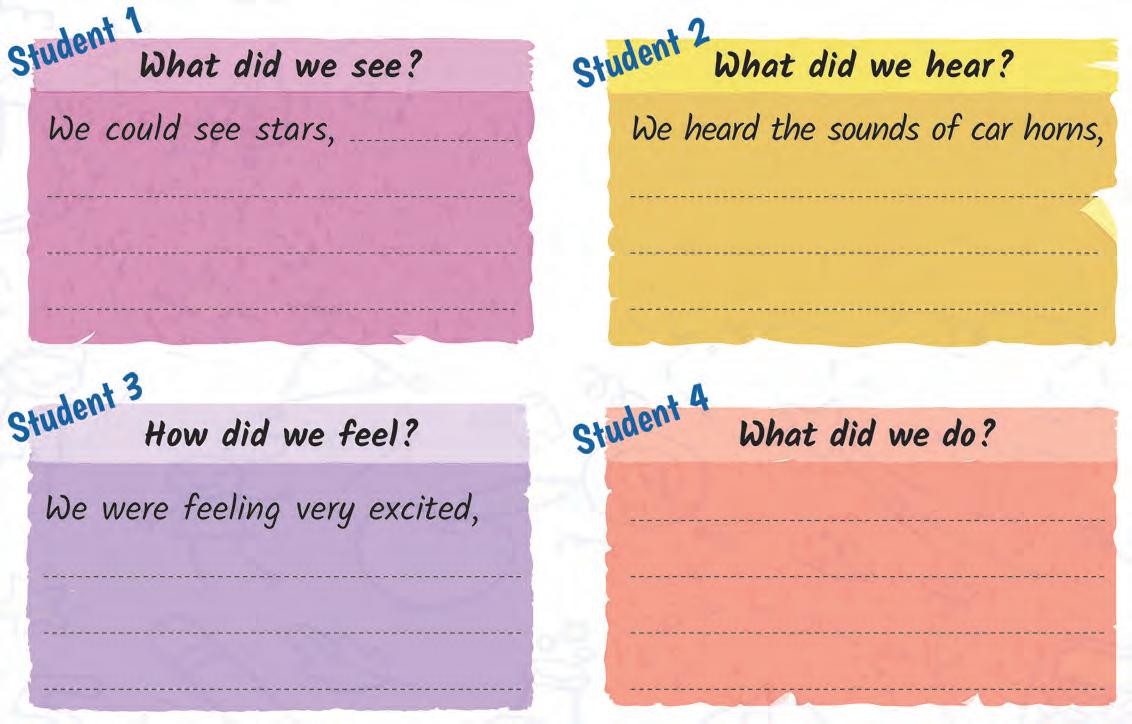
• Invite a few learners to share their rhyming words.
Plan and Speak
An Unforgettable Night
• Warm Up 5 min
A. Recapitulate the activity for the learners.

B. Instruct: Revise your notes in the group. Practise your parts.
• Presentation
• Sample:
and
• Invite ALL the groups for presentation. Select randomly through games. (page vii)
5 min moon, insects on the grass, trees and clouds. happy, scared and sleepy.
Feedback 30 min
the sound of wind blowing and some songs.
We sang many songs. We laughed and played ludo.
Part B - Period 2
12
Appreciate all presentations. Give concrete feedback on content, fluency, presentation style and teamwork.

“Thank you, group! I appreciate your imagination and how nicely you described your experience.
Only one feedback: Try to add more drama and expression to your stories. It makes them fun!
13 Chapter 3 • Let’s Imagine
•
About this book
This “Conversations” book follows a unique spiraling approach that systematically builds language skills and enables children to express themselves verbally in real-world situations, thus preparing them for the needs of the 21st century world. Each chapter focuses on building specific and age-appropriate English language competencies and weaves together activities that are contextual, experiential, joyful and research-based.
Special features of this book:
• Activities based Learning: joyful and experiential activities that build English communication competencies.

• Texts as per NEP 2020 themes: exciting and stimulating texts that pave the way for English communication activities.
• Tech Integration: the book works in sync with the digital world, where various other activities and projects are undertaken. Learner outputs are evaluated through an AI-based speech recognition engine.
• Assessment of Speaking & Listening as per CEFR: the program includes special assessments that allow systematic reporting of skill growth as per the CEFR.
• Teachers’ Manual: the book is complemented by the Teachers’ Manual that enables teachers to conduct each session effectively.
About Uolo
Uolo partners with K12 schools to provide technology-based learning programs. We believe pedagogy and technology must come together to deliver scalable learning experiences that generate measurable outcomes. Uolo is trusted by over 8,000 schools with more than 3 million learners across India, South East Asia, and the Middle East.

Copyright © 2023 all rights reserved.
hello@uolo.com
Singapore | Gurugram | Bengaluru





























